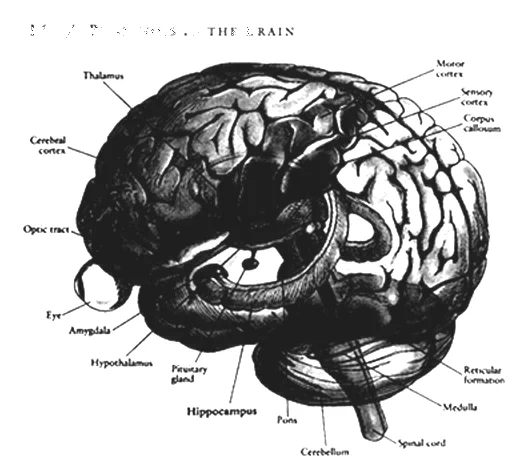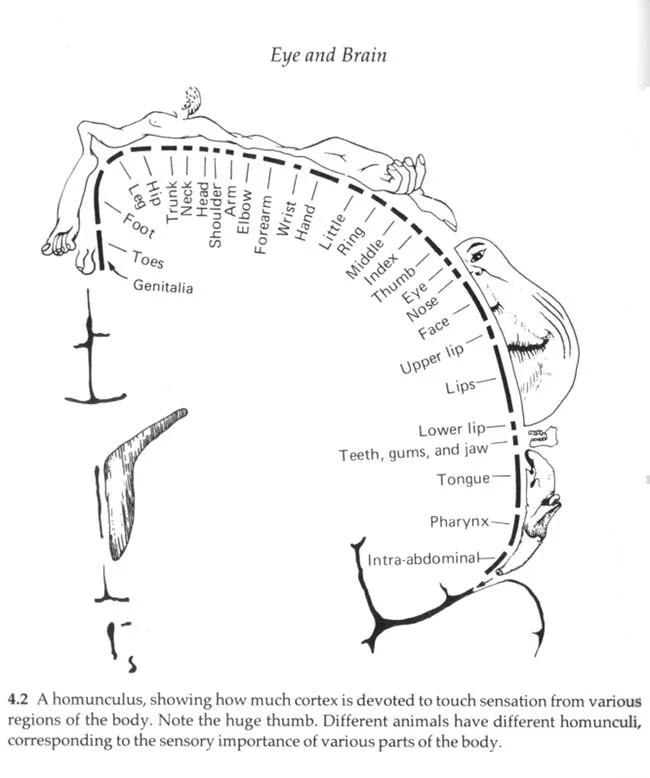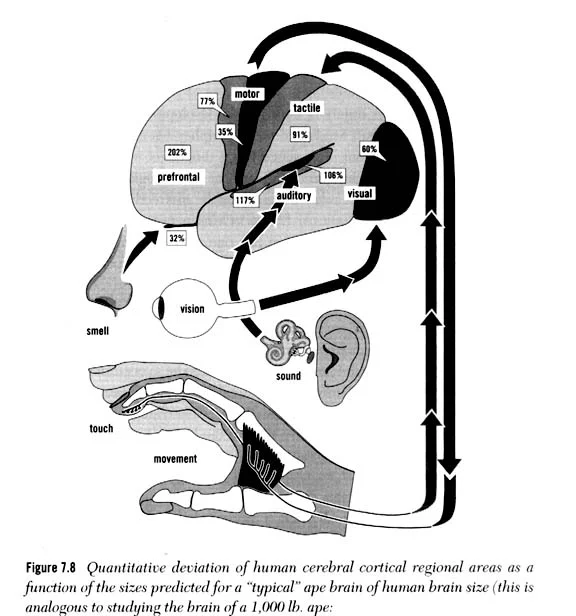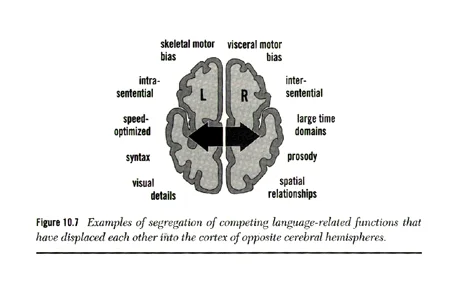"If brains were simple, we would be too simple to understand them." Mario Puzo
How do mental functions map on to the brain? During the 1940's and 1950's, the brilliant Canadian neurosurgeon Wilder Penfield performed extensive brain surgeries on patients with local anaesthetic. During the operations, he stimulated specific regions of the patients' brains with an electrode and simply asked them what they felt. All kinds of sensations, images, and even memories were elicited by the electrode, and the somatosensory areas of the brain that were responsible could be mapped. Penfield concluded that memories left permanent imprints on the brain. (also called engrams) Among other things, Penfield found a narrow strip running from top to bottom down both sides of the brain where his electrode produced sensations localized in various parts of the body. This "sensory homunculus," as it is now called, forms a greatly distorted representation of the body on the surface of the brain, with the parts that are particularly important taking up disproportionately large parts. (see image below) (see also body image ) For the most part, the map is orderly but upside down. However, the map is not entirely continuous. The face is not near the neck, where it should be, but is below the hand. The genitals, instead of being between the thighs, are located below the foot.
V.S Ramachandran has investigated phantom limb syndromes in relation to Penfield's sensory homunculus. He noted that it was possible to feel sensations in the phantom limb when an adjacent area on the Penfield map was touched. Excitation of the phantom hand, for example could be fully mapped onto both the face and the upper arm, which are the two adjacent areas on the cortical map. This phenomenon of "remapping" allows one to dissociate proximity of points on the body surface from proximity of points on the brain map. Remapping shows plasticity in the adult brain circuitry, a flat contradiction of neurological dogma. If the sensory fibers from these areas invade the parts of the cortex devoted to the hand, then feelings from face and upper arm will be felt in the place of the hand. These sensations will not be overridden by any direct sensation from the hand itself. Stimulated by these spurious signals, the brain hallucinates the hand.
According to Ramachandran, the adjacency of the foot and genitals on the Penfield map shows that foot fetishism has a neurogical basis! Ramachandran describes cases in both men and women of pleasurable sensation, including orgasm, occuring in the phantom foot during sex.
Although the kind of point-to-point mappings between areas of the brain and specific mental functions pioneered by Penfield has had its undeniable successes, the coordination of complex functions distributed in the brain remains difficult to understand. While the majority of neurologists favor "parcellation" of the brain, others believe that higher order functions (such as memory, attention, emotion, thought, consciousness, identity) require large-scale or global processes in the brain. While many activities of the brain are functionally segregated and localized, activity is synchronized and coordinated despite the lack of a central coordinatory area. Gerald Edelman calls this capacity reentry.
The "Binding Problem' is an expression of the the issue raised by the non- local interactions of neurons. How can a set of diverse and functionally segregated maps cohere without a higher-order controller? For David Pinker, the mind is a collection of modules, a system of organs, or a society of experts. (p.255)
In his discussion of the localization of language functions in the brain, Terrence Deacon suggests a different approach -- one which lets go of the localization of function while retaining something like the localization of computation -- of how language functions map onto brain functions. The neurological distribution of functions will follow its own logic, which need not parallel a linguistic analysis of these same functions. for Deacon, "The central problem faced by researchers studying the brain and language is that even the minutest divisions of cognitive function we hope to explain at the psychological level are ultimately the productions of the functioning of a whole brain -- even if a damaged one -- whereas the functions we must explain at a neurological level are the operations (or computations) of only a small fragment of this highly integrated and distributed network of functions. " (The Symbolic Species, p.287) (see also vision )
encephalization:
It is generally thought that brain size correlates to intelligence. Yet how does one measure brain size? If it is an absolute measure, eg. mass, then whales should be the most intelligent mammals. If it is a relative measure, then mice come out on top. Or should it be measured within a species rather than between them? If so, is the chihauhau the most intelligent dog? Are dwarves of all species unusually intelligent?
Encephalization is a relationship between the brain and the body. It is the degree to which an animal's actual brain size exceeds what would be predicted for a typical animal of its size. For example, the human brain is about the size that would be expected of a 1000 lb. primate. In The Symbolic Species, Terrence Deacon notes that in human embryonic development, the body ends up underdeveloped. The brain is not overdeveloped. But the relatively small size of the body "frees up" some parts of the brain, to unequal extents. Motor requirements in particular take up proportionally less.
hemispheric specialization:
Oddly enough, the left side of the cortex relates most directly to the right side of the body. (Smell is an exception. The right side of the nose connects to the right side of the brain.) The two cortical sheets are connected by the corpus callosum, which in man has about half a billion nerve fibers, with connections running in both directions.
A century of clinical neurology has shown clearly that the two hemispheres are specialized for different mental capacities. The most striking asymmetry involves language. The left hemisphere (for virtually all right-handed people and most left-handers) is specialized not only for the actual production of speech sounds but also for the imposition of syntactic structures on speech and for much of what is called semantics - comprehension of meaning. The Wernicke's area and the Broca's area are two regions of the left neocortex that process language.
The right hemisphere, on the other hand seems to be concerned with more subtle aspects of language such as nuances of metaphor, allegory, and ambiguity. A person with an extensive stroke to the left hemisphere but with an undamaged right-side brain may still be able to swear and even sing. Such a person may still be able to distinguish a male voice from a female voice.
We tend to call the left hemisphere the major or "dominant" hemisphere.
Other obvious specializations involve vision and emotion. The right hemisphere is concerned with holistic aspects of vision and with the appropriate emotion to evocative situations.
The left brain seems to have a propensity to affirm prior interpretations and to discount, ignore, or reinterpret evidence that runs counter to an already-formed interpretation. (This is called "confirmation bias" by cognitive psychologists. It ressembles Thomas Kuhn's accounts of paradigms and "normal science) The right brain intervenes when it seems that a new hypothesis is required. This is why anosognosia occurs when the right lobe is damaged, but not the left. (se e also phantom limb ) Recent studies have shown demonstrated that the left hemisphere often falsely recognises novel pictures or words that are similar to ones it has been shown recently. But the right hemisphere claims to remember only those pictures or words that match exactly the ones it was shown. The left hemisphere seems to make inferences and associations that make it susceptible to memory disortion, whereas the right hemisphere retains a less embellished and more veridical representation.
schizophrenia was first thought to be an indication of a split in the brain.



